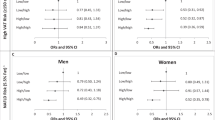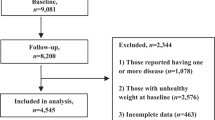Abstract
Background/Objective:
Increasing dietary diversity is concurrent with an increasing prevalence of adiposity in China, but the association between these variables remains ambiguous. This study reveals an association between dietary diversity and body mass (underweight, overweight and obesity) in Chinese adults.
Subjects/Methods:
Data from 17 825 participants (age, 18–65 years) were pooled from four survey waves (2004, 2006, 2009 and 2011) of the Chinese Health and Nutrition Survey. Anthropometric data and dietary intake information obtained through a 24-h dietary recall for 3 consecutive days were collected. Information on covariates, namely those regarding the socioeconomic status and lifestyle of each participant, were collected. The dietary diversity score (DDS) and entropy were used to represent dietary diversity. The association between dietary diversity and adiposity was analyzed by using multivariable-adjusted multinomial logistic regression.
Results:
A positive association between dietary diversity and overweight was detected only in men (DDS: OR=1.09 (1.03–1.17); entropy: OR=1.60 (1.24–2.07)). The results were confirmed by analyzing the interaction between sex and diversity (DDS: OR=1.27 (1.17–1.37); entropy: OR=2.89 (2.11–3.89)). In contrast, no significant association was detected between dietary diversity and underweight/obesity (all P>0.05). Dietary consumption was compared between sexes to explain the different effects of dietary diversity on body mass in men and women. The results indicated that men typically had a higher consumption of meat (P<0.01).
Conclusions:
Higher dietary diversity is positively associated with overweight in men. Additional preventive strategies that promote a healthy diet should focus on men.
This is a preview of subscription content, access via your institution
Access options
Subscribe to this journal
Receive 12 print issues and online access
$259.00 per year
only $21.58 per issue
Buy this article
- Purchase on Springer Link
- Instant access to full article PDF
Prices may be subject to local taxes which are calculated during checkout
Similar content being viewed by others
References
Popkin BM . Will China's nutrition transition overwhelm its health care system and slow economic growth? Health Aff (Millwood) 2008; 27: 1064–1076.
The World Bank World Development Indicators. Washington, DC, USA 2012.
Tian X, Yu XH . Using semiparametric models to study nutrition improvement and dietary change with different indices: the case of China. Food Policy 2015; 53: 67–81.
Tian X, Yu XH . The demand for nutrients in China. Front Econ China 2013; 8: 186–206.
Jones AD, Shrinivas A, Bezner-Kerr R . Farm production diversity is associated with greater household dietary diversity in Malawi: findings from nationally representative data. Food Policy 2014; 46: 1–12.
Ludwig DS . Technology, diet, and the burden of chronic disease. JAMA 2011; 305: 1352–1353.
Batis C, Sotres-Alvarez D, Gordon-Larsen P, Mendez MA, Adair L, Popkin B . Longitudinal analysis of dietary patterns in Chinese adults from 1991 to 2009. Br J Nutr 2014; 111: 1441–1451.
Zhai FY, Du SF, Wang ZH, Zhang JG, Du WW, Popkin BM . Dynamics of the Chinese diet and the role of urbanicity, 1991-2011. Obes Rev 2014; 15: 16–26.
Gordon-Larsen P, Wang H, Popkin BM . Overweight dynamics in Chinese children and adults. Obes Rev 2014; 15: 37–48.
Xi B, Liang Y, He T, Reilly KH, Hu Y, Wang Q et al. Secular trends in the prevalence of general and abdominal obesity among Chinese adults, 1993-2009. Obes Rev 2012; 13: 287–296.
Wildman RP, Gu D, Muntner P, Wu X, Reynolds K, Duan X et al. Trends in overweight and obesity in Chinese adults: between 1991 and 1999-2000. Obesity (Silver Spring) 2008; 16: 1448–1453.
de Mutsert R, Sun Q, Willett WC, Hu FB, van Dam RM . Overweight in early adulthood, adult weight change, and risk of type 2 diabetes, cardiovascular diseases, and certain cancers in men: a cohort study. Am J Epidemiol 2014; 179: 1353–1365.
De Pergola G, Silvestris F . Obesity as a major risk factor for cancer. J Obes 2013; 2013: 291546.
Berentzen TL, Gamborg M, Holst C, Sorensen TI, Baker JL . Body mass index in childhood and adult risk of primary liver cancer. J Hepatol 2014; 60: 325–330.
Mirmiran P, Azadbakht L, Azizi F . Dietary diversity within food groups: an indicator of specific nutrient adequacy in Tehranian women. J Am Coll Nutr 2006; 25: 354–361.
Kennedy E . Dietary diversity, diet quality, and body weight regulation. Nutr Rev 2004; 62: S78–S81.
Ulbricht TL, Southgate DA . Coronary heart disease: seven dietary factors. Lancet 1991; 338: 985–992.
Papandreou C, Tuomilehto H . Coronary heart disease mortality in relation to dietary, lifestyle and biochemical risk factors in the countries of the Seven Countries Study: a secondary dataset analysis. J Hum Nutr Diet 2014; 27: 168–175.
Wiseman M . The second World Cancer Research Fund/American Institute for Cancer Research expert report. Food, nutrition, physical activity, and the prevention of cancer: a global perspective. Proc Nutr Soc 2008; 67: 253–256.
Krebs-Smith SM, Smiciklas-Wright H, Guthrie HA, Krebs-Smith J . The effects of variety in food choices on dietary quality. J Am Diet Assoc 1987; 87: 897–903.
Li N, An Engel Curve For Variety 2011, Availbale at: http://siteresources.worldbank.org/INTMACRO/Resources/NicholasLiindpaperdraft_v4j.pdf.
Foote JA, Murphy SP, Wilkens LR, Basiotis PP, Carlson A . Dietary variety increases the probability of nutrient adequacy among adults. J Nutr 2004; 134: 1779–1785.
Remick AK, Polivy J, Pliner P . Internal and external moderators of the effect of variety on food intake. Psychol Bull 2009; 135: 434–451.
Vadiveloo M, Dixon LB, Mijanovich T, Elbel B, Parekh N . Dietary variety is inversely associated with body adiposity among US adults using a novel food diversity index. J Nutr 2015; 145: 555–563.
Salehi-Abargouei A, Akbari F, Bellissimo N, Azadbakht L . Dietary diversity score and obesity: a systematic review and meta-analysis of observational studies. Eur J Clin Nutr 2016; 70: 1–9.
Vadiveloo M, Dixon LB, Parekh N . Associations between dietary variety and measures of body adiposity: a systematic review of epidemiological studies. Br J Nutr 2013; 109: 1557–1572.
WHO, Expert, Committee Physical Status: The Use And Interpretation Of Anthopometry: Report of a WHO Expert Committee. WHO Technical Report Series 854. World Health Organization: Geneva, 1995.
Zhang B, Zhai FY, Du SF, Popkin BM . The China Health and Nutrition Survey, 1989-2011. Obes Rev 2014; 15: 2–7.
Kant AK, Schatzkin A, Harris TB, Ziegler RG, Block G . Dietary diversity and subsequent mortality in the First National Health and Nutrition Examination Survey Epidemiologic Follow-up Study. Am J Clin Nutr 1993; 57: 434–440.
Liu J, Shively GE, Binkley JK . Access to variety contributes to dietary diversity in China. Food Policy 2014; 49: 323–331.
Denzil G, Renate F, Theil H . More on goodness of fit of allocation models. Econ Lett 1984; 15: 5–11.
Azadbakht L, Esmaillzadeh A . Dietary energy density is favorably associated with dietary diversity score among female university students in Isfahan. Nutrition 2012; 28: 991–995.
Azadbakht L, Esmaillzadeh A . Dietary diversity score is related to obesity and abdominal adiposity among Iranian female youth. Public Health Nutr 2011; 14: 62–69.
Chambers JC, Elliott P, Zabaneh D, Zhang W, Li Y, Froguel P et al. Common genetic variation near MC4R is associated with waist circumference and insulin resistance. Nat Genet 2008; 40: 716–718.
Frayling TM, Timpson NJ, Weedon MN, Zeggini E, Freathy RM, Lindgren CM et al. A common variant in the FTO gene is associated with body mass index and predisposes to childhood and adult obesity. Science 2007; 316: 889–894.
Mutch DM, Clement K . Unraveling the genetics of human obesity. PLoS Genet 2006; 2: e188.
Thorleifsson G, Walters GB, Gudbjartsson DF, Steinthorsdottir V, Sulem P, Helgadottir A et al. Genome-wide association yields new sequence variants at seven loci that associate with measures of obesity. Nat Genet 2009; 41: 18–24.
Huypens P, Sass S, Wu M, Dyckhoff D, Tschop M, Theis F et al. Epigenetic germline inheritance of diet-induced obesity and insulin resistance. Nat Genet 2016; 48: 497–499.
Kant AK, Graubard BI . A comparison of three dietary pattern indexes for predicting biomarkers of diet and disease. J Am Coll Nutr 2005; 24: 294–303.
Lee MS, Huang YC, Su HH, Lee MZ, Wahlqvist ML . A simple food quality index predicts mortality in elderly Taiwanese. J Nutr Health Aging 2011; 15: 815–821.
Kimura Y, Okumiya K, Sakamoto R, Ishine M, Wada T, Kosaka Y et al. Comprehensive geriatric assessment of elderly highlanders in Qinghai, China IV: comparison of food diversity and its relation to health of Han and Tibetan elderly. Geriatr Gerontol Int 2009; 9: 359–365.
Dodd KW, Guenther PM, Freedman LS, Subar AF, Kipnis V, Midthune D et al. Statistical methods for estimating usual intake of nutrients and foods: a review of the theory. J Am Diet Assoc 2006; 106: 1640–1650.
Garriguet D . Under-reporting of energy intake in the Canadian Community Health Survey. Health Rep 2008; 19: 37–45.
Acknowledgements
We thank the National Institute of Nutrition and Food Safety, China Centre for Disease Control and Prevention; the Carolina Population Centre, University of North Carolina at Chapel Hill; the National Institutes of Health (NIH; R01-HD30880, DK056350 and R01-HD38700); and the Fogarty International Centre, NIH for their financial contribution to the CHNS data collection and analysis files. The study was sponsored by the National Natural Science Foundation of China (Project IDs: 81402741 and 71473123), and the Natural Science Foundation of the Jiangsu province (BK20140904). A project was also funded by the Priority Academic Program Development of Jiangsu Higher Education Institutions.
Author contributions
Data extraction, integrity and accuracy by XT, MW and YZ. Data analysis and interpretation by XT, MW and JZ. Manuscript drafting by XT, MW, YZ and HW. Study concept and design, and critical revision of the manuscript by XT, MW, YZ, JZ and HW. Acquirement offunding and study supervision by XT and HW.
Author information
Authors and Affiliations
Corresponding author
Ethics declarations
Competing interests
The authors declare no conflict of interest.
Additional information
Supplementary Information accompanies this paper on European Journal of Clinical Nutrition website
Rights and permissions
About this article
Cite this article
Tian, X., Wu, M., Zang, J. et al. Dietary diversity and adiposity in Chinese men and women: an analysis of four waves of cross-sectional survey data. Eur J Clin Nutr 71, 506–511 (2017). https://doi.org/10.1038/ejcn.2016.212
Received:
Revised:
Accepted:
Published:
Issue Date:
DOI: https://doi.org/10.1038/ejcn.2016.212
This article is cited by
-
Dairy consumption in adults in China: a systematic review
BMC Nutrition (2023)
-
Geographic and urban–rural disparities in dietary energy and macronutrient composition among women of childbearing age: findings from the China health and nutrition survey,1991–2015
Nutrition Journal (2023)
-
Dietary diversity score and cardio-metabolic risk factors: an updated systematic review and meta-analysis
Eating and Weight Disorders - Studies on Anorexia, Bulimia and Obesity (2022)
-
Maternal dietary diversity during pregnancy and congenital heart defects: a case-control study
European Journal of Clinical Nutrition (2021)
-
Adherence to Lifelines Diet Score (LLDS) is associated with better sleep quality in overweight and obese women
Eating and Weight Disorders - Studies on Anorexia, Bulimia and Obesity (2021)



